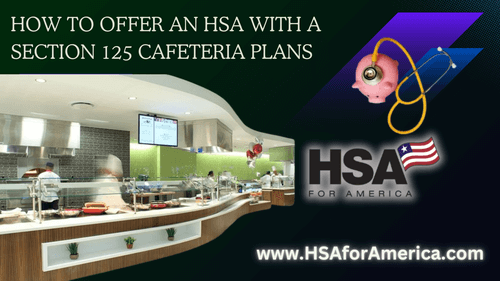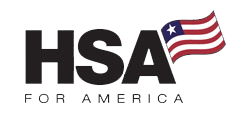
Section 125 Cafeteria Plans & HSAs
If you’re a small business owner or executive and you’re considering offering an HSA benefit within a Section 125 Cafeteria plan, this blog is for you.
In this blog we’ll discuss what a Section 125 plan is, how it works, and give you a step-by-step plan of action to implement your new Cafeteria plan design.
Compare Pricing on the Best Insurance Plans Available
What’s a Section 125 Cafeteria Plan?
A Section 125 Cafeteria Plan is an employer-sponsored benefits program that allows employees to pay for certain qualified employee benefits on a pre-tax basis.
Health savings accounts are one of the more common benefits available within a Section 125 cafeteria plan.
Named after Section 125 of the Internal Revenue Code, these plans offer significant tax advantages for both employers and employees.
They’re called “cafeteria” plans because eligible employees can pick and choose which benefits offered inwithin the plan they’d like to purchase or contribute to the Section 125 plan.
125 plans effectively offer a menu of benefit options, including a medical plan, dental and/or vision insurance, group term life insurance, disability income assistance, hospitalization or accident insurance, a flexible spending arrangement (FSA), and many others.
At a minimum, however, a Section 125 plan must include at least one taxable benefit option and one qualified pre-tax benefit.
Employees can choose any, all, or none of these benefits based on their situation and budget. If they do choose to contribute, or pay premiums or expenses for these benefits, they do so using pre-tax dollars. The amounts they pay via payroll deduction are not included in the employee’s gross income and not subject to federal income tax nor Social Security/payroll taxes.
So why would an employer set up a Section 125? Multiple reasons: It’s not only convenient for the employee -– it also saves taxes for the employee as well. You’re essentially giving a compensation increase for each worker who participates, without having to pay extra yourself.
In fact, setting up a Section 125 immediately saves money for you, the employer as well. Every dollar an employee diverts through the Section 125 plan is a dollar you don’t have to pay Social Security and payroll tax.
And, of course, any dollars you contribute to employee HSAs or any other benefits within the cafeteria plan, including life insurance premiums for a death benefit of up to $50,000 under Section 7702, is deductible to your business as a compensation expense.
So, Section 125 plans are a win-win proposition for workers alike. The more workers use them, the greater the tax benefits for both sides.
Types of Section 125 Cafeteria Plans
The first step in offering an HSA benefit within a Section 125 plan is establishingto establish the Section 125 plan.
As an employer, you can establish one of these three types of cafeteria plans:
Full-Flex Plans
With these plans, you’ll provide each eligible worker with a fixed-dollar amount.
Your employees can allocate this amount among the cafeteria plans’ benefits as they see fit. If the cost of the selected benefits exceeds the worker’s contribution, employees can use pre-tax salary deductions to cover the difference.
Premium-Only Plans (POPs)
These plans allow employees to pay their share of health insurance premiums on a pre-tax basis, reducing their taxable income.
Simple Cafeteria Plans
Designed for small businesses with 100 or fewer employees, these plans offer a safe harbor from certain nondiscrimination requirements in exchange for employer contributions to employee benefits.
Compliance: Non-Discrimination Rules for Section 125 Cafeteria Plans
Before starting your Section 125 Cafeteria plan, you must understand its various nondiscrimination and compliance requirements.
Congress doesn’t want the tax benefits of Section 125 plans to accrue disproportionately to owners, management, and highly compensated employees (HCEs). That’s why Congress and the IRS established non-discrimination rules that apply to all Section 125 plans.
To pass muster, your Section 125 must pass three non-discrimination tests: the Eligibility Test, the Contributions and Benefits Test, and the Key Employee Compensation Test. Let’s take a look at each of these tests in turn.
How to Pass the Eligibility Test
The Eligibility Test is as follows:
Your plan must benefit at least 70% of all non-excludable employees or;
Your plan must benefit at least 80% of all non-excludable employees who are eligible to benefit, if 70% or more of all non-excludable employees are eligible to benefit under the plan, or;
Your plan must benefit from a nondiscriminatory classification of employees based on bona fide business criteria.
How to Pass the Contributions and Benefits Test
Your plan must not discriminate in favor of highly-compensated employees (HCEs) in either contributions or benefits.
For example, the contribution percentages for highly compensated employees should not be higher than for rank-and-file workers.
Similarly, rank and file workers shouldn’t pay more for the same benefits than non-highly-compensated employees.
For the purposes of Section 125 compliance, highly compensated individuals include:
- Corporate officers of the employer
- Shareholders with more than 5% of the voting power or more than 5% of the total value of all classes of employer stock
- Workers with compensation of $150,000 or higher (as of 2024).
- Spouses or dependents of any of these individuals.
Note: The definition of a highly compensated individual under Section 125 is broader than the definition of a highly compensated employee under Section 414(q). The Section 125 definition includes officers and shareholders owning more than 5%, in addition to the compensation-based test.
How to Pass the Key Employee Concentration Test
The plan’s benefits can’t be concentrated among key employees. For example, key employees cannot receive more than 25% of the benefits under the plan.
If it does, the benefits under the Section 125 plan for those key employees become taxable.
The Section 125 Cafeteria Plan Testing and Compliance Process
- Annual Testing. Employers must perform non-discrimination testing annually, typically as of the last day of the plan year. It is also recommended that mid-year tests be conducted to identify and correct potential issues before the plan year’s end.
- Documentation. Employers should maintain detailed records of the testing results and any corrective actions taken. This documentation is crucial in case of an IRS audit
Safe Harbor Provisions
Employers with 100 employees or less can choose to create a more streamlined plan called a simple cafeteria plan.
These simple plans are deemed to satisfy non-discrimination rules as long as certain contribution and eligibility rules criteria are met.
Premium Only Plans
If a Premium-Only-Plan passes the eligibility test, it’s deemed to have passed all the other non-discrimination rules as well.
However, you wouldn’t set up a premium-only plan if you intended to use the plan to contribute to employee HSAs.
Decide HSA Eligibility Criteria
Who will be eligible for your employer’s HSA contribution benefit?
Ultimately, that decision is up to the individual business. You could limit eligibility to only the workers themselves or extend it to include dependents and family members. You can also choose to restrict benefits to full-time workers or extend them to part-time workers.
However, you must extend the same benefits to all workers in each class.
Decide How Much Your Business Will Contribute
As of 2024, the maximum allowable contribution to a health savings account is $4,150 for a plan covering a single individual, and $8,300 for families. Those 55 and older are eligible for an additional $1,000 each in “catch-up” contributions.
Both worker contributions and employer contributions count towards the limit.
As an employer, you can decide to contribute the entire allowable amount, a percentage of it, or nothing. You can include family members in your calculation or you can choose to only contribute for the employees themselves, and exclude family members (though your workers can certainly contribute to a family HSA, as long as the total doesn’t exceed $8,300 per year (plus allowable catch-up contributions) as of 2024.
For 2025, the limits are going up slightly, to $4,300 for an individual and $8,550 for a family plan.
You and your employees have until April 15th to complete your HSA contributions for the prior year.
Offer a High Deductible Health Plan
All workers who contribute to HSAs or who benefit from employer contributions to their HSAs must have health insurance under a qualified high-deductible health plan (HDHP).
They must also not have access to first-dollar coverage under another plan, such as VA Health Care or Medicare.
Most major group health insurance carriers offer some form of HDHP to employers.
The best HDHP available will depend on your location and budget for health benefits. But you can offer multiple plans for employees to choose from. For help choosing the best HDHP in your area, and for guidance on overall plan design, contact an expert HSA for America Personal Benefits Manager.
Hire a Third Party Administrator (TPA)
While it’s possible to administer your cafeteria plan in-house, most smaller companies that don’t have an in-house full-time HR department choose to to contract an outside third-party administrator to do it.
Your TPA will provide expert guidance and handle the necessary documentation, nondiscrimination testing, and compliance tasks. So you can concentrate on overall policy, without struggling with the day-to-day workings of your plan and the minutiae of compliance regulations.
Choose an HSA Custodian
The custodian is a third-party financial institution that holds HSA assets, records, and documents transactions, and reports them to the IRS.
When choosing an HSA custodian, consider the following factors:
Fee structure
- Monthly Maintenance Fees. Look for custodians with low or no monthly maintenance fees. Some custodians charge fees ranging from $0 to $5 per month, while others may waive fees if a minimum balance is maintained.
- Transaction Fees. Be aware of fees for transactions such as fund transfers, ATM withdrawals, and investment transactions. Some custodians charge for these services, which can add up over time.
- Hidden Fees. Watch out for hidden fees like paper statement fees, account closure fees, and insufficient funds fees. These can erode the value of the HSA over time.
Investment options
- Variety of Investment Choices. Ensure the custodian offers a range of investment options, including low-cost index funds, mutual funds, ETFs, and other investment vehicles. This allows employees to grow their HSA funds over time.
- Account minimums. Some custodians require a minimum balance before employees can start investing. Make sure these thresholds are reasonable and clearly communicated.
Ease of use
- Online and Mobile Access. Choose a custodian with a robust online platform and mobile app that allows employees to easily manage their accounts, view balances, make transactions, and access investment options.
- Ease of Use. The platform should be user-friendly and intuitive, making it easy for employees to navigate and manage their accounts without extensive training.
Integration With Payroll Systems
- Seamless Integration: Choose a custodian that can integrate with your existing payroll and benefits administration systems. This can streamline the process of making contributions and managing employee accounts.
- Automated Processes: Look for features like automated enrollment, contribution processing, and notifications to reduce the administrative burden on HR and benefits teams.
Learn More: The Best health Savings Account Administrators in 2026 – A Guide to HSA Banks
Create a Summary Plan Description
All Section 125 plan sponsors must create a Summary Plan Description or SPD by law.
A Section 125 Summary Plan Description (SPD) is a crucial document that provides employees with a clear and comprehensive overview of their cafeteria plan benefits. The SPD must be written in plain language and include specific information to ensure compliance with IRS and Department of Labor (DOL) regulations. Here are the key components that must be included in a Section 125 SPD:
1. Plan Information
- Plan Name. The official name of the Section 125 plan.
- Plan Sponsor. The name and address of the employer sponsoring the plan.
- Plan Administrator. The name and address of the individual or entity responsible for managing the plan. Most small businesses hire a third-party administrator rather than do it in-house.
2. Eligibility and Participation
- Eligibility Requirements. Detailed criteria for employee eligibility, including any waiting periods and the conditions under which employees can participate in the plan.
- Participation Rules. Information on how employees can enroll in the plan, including enrollment periods, effective dates, and the process for making pre-tax elections.
3. Benefits Offered
- Description of Benefits. A comprehensive description of the benefits available under the plan, such as health insurance premiums, Flexible Spending Accounts (FSAs), Dependent Care Assistance Plans (DCAPs), and Health Savings Accounts (HSAs).
- Use-It-or-Lose-It Provisions. For FSAs, information about the “use-it-or-lose-it” provision, which states that any unused funds at the end of the plan year are forfeited unless a grace period or carryover option is provided.
4. Contributions and Funding
- Employee Constributions. Details on how employees can make contributions to the plan, including salary reduction agreements and maximum contribution limits.
- Employer Contributions. Information on whether the employer will make contributions to the plan and the conditions under which these contributions are made.
5. Plan Year and Administration
- Plan Year. The 12-month period during which the plan operates, typically aligning with the calendar year or the employer’s fiscal year.
- Administrative Procedures. Procedures for making elections, changing elections due to qualifying events, and the process for handling claims and reimbursements.
6. Non-Discrimination Testing
Compliance Information. An explanation of the non-discrimination rules that apply to the plan, ensuring that it does not favor highly compensated employees or key employees. This includes details on the annual non-discrimination tests that must be conducted.
7. ERISA Requirements
If the plan is subject to the Employee Retirement Income Security Act (ERISA), the SPD must include information on participants’ rights under ERISA, including the right to receive information about the plan, the right to a fair process for benefit claims, and the right to sue for benefits and breaches of fiduciary duty.
8. Claims and Appeals Process
- Claims Procedures. Detailed instructions on how employees can file claims for benefits, including the timeframes for submitting claims and the documentation required.
- Appeals Process. Information on the process for appealing denied claims, including the steps for requesting a review and the timeframes for receiving a decision.
9. Invest In Employee Education and Communication
Employee benefits plans don’t run themselves.
It’s not enough to just have a plan in a binder on a shelf, gathering dust in the HR Director’s office. It’s not enough to just offer a health plan. You need to invest time and effort in helping your workers understand their options as well as how their HSA benefits work.
The more you invest in employee communication, the more value they will see in your suite of benefits.
That’s why it’s crucial to educate employees about the benefits and usage of HSAs and other benefits in your cafeteria plans. Providing resources and ongoing support can help employees maximize the advantages of these benefits, leading to higher satisfaction and better utilization.
10. Document and Report
Work closely with your employee payroll vendor to ensure all employee and employer HSA contributions and other Section 125 transactions are captured on employee W2s and other reporting firms.
Report employer contributions to HSAs on employee W-2 forms using Code W in Box 12.
File Form 5500 with the Department of Labor each year.
Compare Pricing on the Best HealthShare Plans Available
Don’t Go It Alone
Your HSA for America Personal Benefits Manager can help advise you on benefits design, the HSA itself, and how to combine multiple different strategies and approaches to help you save money and stay competitive while still providing the access to healthcare your workers deserve, and that the modern competitive labor market demands.
For a free consultation, make an appointment with a Personal Benefits Manager.
For Further Reading: Journal of Accountancy: Cafeteria Plan Compliance | Health Care For Small Businesses: Best Strategies for Employers With 2 to 20 Employees | The Small Business Owner’s Guide to Starting a Section 125 Cafeteria Plan

Hi! I’m Mike Montes, and I’m one of your Personal Benefits Managers. I like working with HSA for America because we’re creating solutions to healthcare problems. Our focus on money-saving alternatives like HSA plans and health sharing programs, and the variety of health share programs we offer, are what set us apart. Read more about me on my Bio page.


